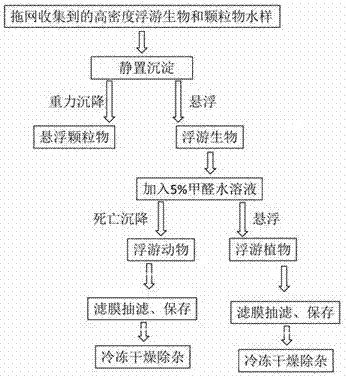Method for separating particulate matters and plankton from water body efficiently and quickly
A technology for plankton and particulate matter, which is applied in the direction of removing certain components, weighing, and preparing samples for testing. It can solve the problems of difficult separation, high price, and large loss, reducing experimental errors and wide application. , the effect of simple operation
- Summary
- Abstract
- Description
- Claims
- Application Information
AI Technical Summary
Problems solved by technology
Method used
Image
Examples
Embodiment 1
[0035] Example 1 Separation of plankton and particulate matter in Liuxi River-Pearl River water body
[0036] In this example, the collection and separation of plankton and suspended particulate matter in the water body from the lower reaches of the Liuxi River in Guangzhou to the Pearl River will be described. The sample points were selected according to the "Research Methods of Freshwater Plankton", and the sampling method was based on the requirements for sample collection of plankton and suspended particulate matter in "Water and Wastewater Monitoring and Analysis Methods (Fourth Edition)".
[0037] The operation steps are as follows:
[0038] S1. Put the water body mixed with plankton and suspended particles into static settlement, and collect the middle and lower layers of water containing particles and the near-surface water containing suspended plankton;
[0039]S2. add separation liquid to the near-surface water body containing suspended phytoplankton and plants coll...
Embodiment 2
[0049] Example 2 Collection and separation of plankton and particulate matter in the water body of Dashahe Reservoir
[0050] This embodiment is illustrated by collecting and separating plankton and suspended particulate matter in the water body in Dashahe Reservoir, Jiangmen City. The sample points were selected according to the "Research Methods of Freshwater Plankton", and the sampling method was based on the requirements for sample collection of plankton and suspended particulate matter in "Water and Wastewater Monitoring and Analysis Methods (Fourth Edition)". The specific operation process of collection and separation is the same as that in Example 1. Different from the section from Liuxi River to the Pearl River, there are fewer suspended particles in the water body of Dasha River Reservoir, and the density of phytoplankton (cyanophyta, chlorophyta) and zooplankton is higher. The collected high-density plankton is dark green, mainly Microcystis that caused a slight "bl...
PUM
| Property | Measurement | Unit |
|---|---|---|
| Mesh aperture | aaaaa | aaaaa |
Abstract
Description
Claims
Application Information
 Login to View More
Login to View More - R&D
- Intellectual Property
- Life Sciences
- Materials
- Tech Scout
- Unparalleled Data Quality
- Higher Quality Content
- 60% Fewer Hallucinations
Browse by: Latest US Patents, China's latest patents, Technical Efficacy Thesaurus, Application Domain, Technology Topic, Popular Technical Reports.
© 2025 PatSnap. All rights reserved.Legal|Privacy policy|Modern Slavery Act Transparency Statement|Sitemap|About US| Contact US: help@patsnap.com

